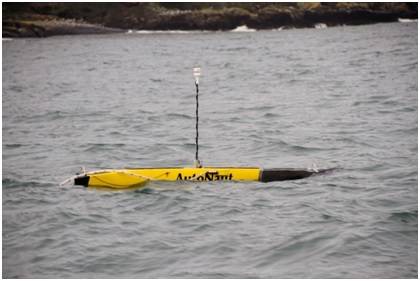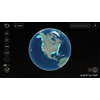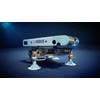AutoNaut Launches at Oceanology International

AutoNaut towing an 18m low profile array which can be seen as a pipe on the starboard side, disappearing over the stern.
AutoNaut is a wave-propelled vessel for ocean research being launched today at Oceanology International in London. Built by MOST (Autonomous Vessels) Ltd. for very long endurance autonomous data gathering the 3.5 meter AutoNaut also harvests solar energy at sea to power her state of the art electronics.
The new unmanned surface vessel (USV) uses motion from the ocean to propel herself, silently, with stability and zero emissions.
Fresh back from sea trials with AutoNaut in Scotland founder Directors David Maclean and Mike Poole are on hand at Oi 2014, stand D445, to explain her potential and answer questions as visitors get their first chance to see the unique vessel.
“AutoNaut is revolutionary,” said Mike Poole, “because it is the first commercial use of a wave propulsion technology that can be scaled from a 1 meter hull to a ship. Such zero emission power, using the energy of the waves to propel a vessel, has great future potential for the marine world.”
David Maclean said, “It is a great moment to launch our AutoNaut USV to the world here today. Interest until now has come through the industry grape vine. We have made our first sale, for delivery to the USA soon after Oi. We are working with a range of other industry ‘early adopters’ to build boats to meet their specific needs.
“We are finding a wide range of different uses requiring boats from 1 to 5 meters long, to carry an even wider range of sensors. After a year of intensive development we are ready to launch into the new markets made possible by AutoNaut’s unique capabilities.”
LATEST SEA TRIAL SUCCESS
In sea trials off Oban a fortnight ago AutoNaut’s high tech platform control system enabled her to follow tracks between waypoints within a few meters, automatically calculating the allowance for tide and wind as she progressed at around 2 knots, on all headings relative to the wind and waves.
“We are delighted with this success,” said Mike Poole.“It means for example that AutoNaut, powered solely by the waves, could accurately follow and survey a submarine cable. We also confirmed her station keeping capability, on the day within a 15 meter radius, and repeated grid transects.”
AutoNaut was released to operate autonomously, with control from ashore through 24/7 Iridium satellite communications. She also logged weather and seawater data from sensors installed on the mast and through the hull.
The 3.5 meter AutoNaut USV on show is built for a contract under the Government-backed Small Business Research Initiative (SBRI) to develop vehicles – known generically as Long Endurance Marine Unmanned Surface Vehicles (LEMUSV) - that will carry out sustained marine research over long periods. The Technology Strategy Board and Natural
Environment Research Council jointly fund the program with supplementary funding of additional elements from the Defense Science and Technology Laboratory (Dstl).
AutoNaut represents a new level of capability for very long endurance ocean research and data gathering. The patented wave propulsion technology is scalable, so larger boats can offer more speed, carrying capacity, and payload power.“Other specific AutoNaut USV advantages are persistence, really only limited by antifouling needs,” said Mike Poole, “zero emissions, a good speed –up to 3 knots for a 3 meter hull - ample payload power which can be boosted with a methanol fuel cell, and ease of deployment by trailer off a slipway, or from a ship.”
These attributes in turn make possible not only cheaper data gathering, but also better continuity and granularity of data in all weathers.
AutoNaut offers the possibility of autonomously networking other underwater assets from the surface to shore, or remote support ship. And she can act as an unmoored buoy, so saving mooring costs.
NEW TOWED ARRAY LAUNCHED WITH AUTONAUT
As part of the LEMUSV project, AutoNaut’s first sea trial with a live towed array took place in November and proved a successful combination for two new UK designs. In a chilly 15 knot wind and small chop AutoNaut deployed and towed an 18 meter low profile acoustic array. The NarcineArray is also being launched at Oi today, on stand P600. AutoNaut’s speed of around two knots was not noticeably changed and her steering remained good, with a series of circles being completed without difficulty.
“It was great to see a real array in action with the new boat,” said Mike Poole. The new miniaturized low profile array is provided by J+S Ltd, a UK engineering company with bases in Barnstaple and Aberdeen. Ease of handling and the robust nature of the array were clearly demonstrated. The array was able to track a target of opportunity and, with the absence of tow vessel noise, 360 degree acoustic coverage was achieved.
Andy Toms, Managing Director for J+S said “This successful trial is the result of months of intensive sonar engineering work by our Product Development Team. The collaboration with MOST (AV) demonstrates the potential of our LPA technology as a lightweight, easily deployed, acoustic sensing system”
Mike Poole, Director of MOST (AV) commented, “Our collaboration with J+S Ltd is a triumph of innovative UK engineering expertise at its best.”
















 February 2024
February 2024



